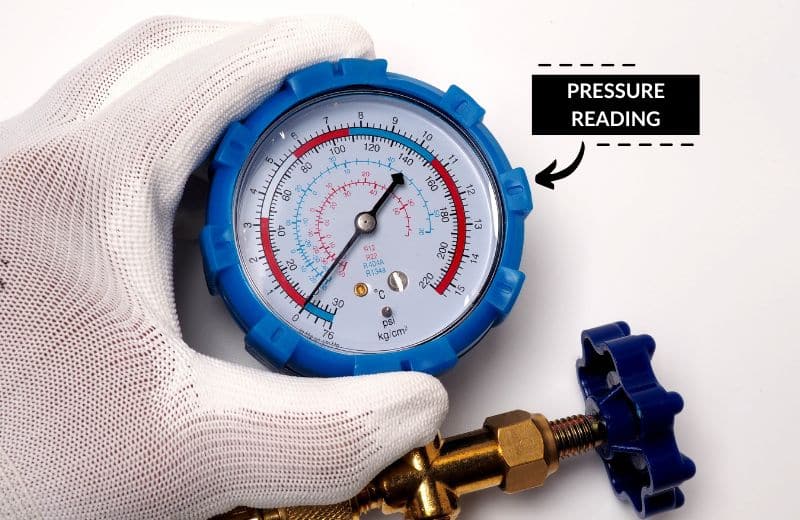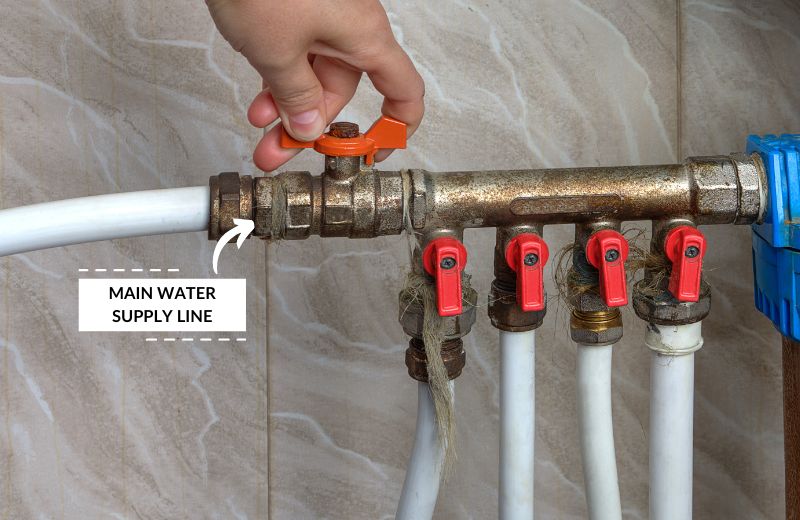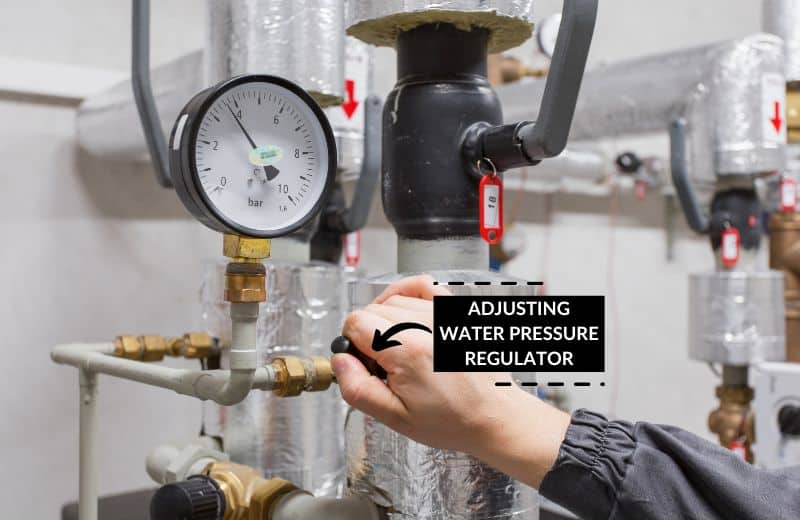Checking your water pressure is a task that’s worth doing at least a couple of times a year as part of your general plumbing maintenance.
It’s easy to check your water pressure at home: you just need an inexpensive pressure gauge – and some homes even have this built into the plumbing system.
Here, we’ve shared everything you need to know on how to quickly check your home’s water pressure.
📌 Key Takeaways:
- You should test your home’s water pressure to ensure you have the right system pressure to meet your water demands without damaging your plumbing and fixtures.
- To test your water pressure, you need a pressure gauge. Choose your testing spot at your household plumbing (most people choose an outside spigot), firmly attach the gauge, and take a reading.
- If you discover that your water pressure is too high or too low, you can take the appropriate steps to resolve the issue.
Table of Contents
🤔 Why Test Your Home’s Water Pressure?
You should test your home’s water pressure to check that the pressure is adequate for meeting your daily water needs, even at peak usage periods, and that your plumbing isn’t at risk of being damaged by excess pressure.
If you regularly test your water pressure, you’ll come to learn the normal pressure range in your plumbing system, so you can detect issues with the pressure regulator or the pressure-reducing valve before the problem is able to progress.

📖 How To Test Water Pressure: Step-By-Step
Follow this process to quickly and easily test your water pressure at home.
Step 1: Gather Your Tools & Equipment
Start by gathering what you’ll need for testing water pressure.
You will need:
- A water pressure gauge
- A rag
- A wrench
You can buy a water pressure gauge from most hardware stores. You don’t have to pay a fortune for this device – just make sure it has a rubber gasket for a tight seal and female hose threads to simplify hook-up. It should also be able to take an accurate reading for water pressure up to 300 PSI.
Step 2: Pick A Spot To For Testing
Next, choose where you want to test your water pressure.
If you’re on a private well system, the ideal testing spot is a fixture or faucet that’s located near the well’s pressure tank. It’s best to choose a faucet or hose bib that’s fed by the water pipe that’s biggest in your house, rather than testing at a smaller pipe, such as a water pipe in your bathroom.
If you get your water from a municipal water utility (otherwise known as a city supplier), the best place to test water pressure is as close as possible to where the main water supply line enters your home (closest to your water meter). Ideally, this should be an outside location, like your outdoor hose.
If you don’t have an outside spigot, you could also test your water pressure at your washing machine.

Step 3: Switch Off Any Fixtures Or Appliances
When it comes to taking your pressure reading, you need to first make sure that none of your fixtures or appliances are using water in your home. That’s because you’re aiming to measure static water pressure, when water isn’t moving elsewhere through your home’s pipes.
Switch off any dishwashers, washing machines, refrigerators with water dispensers, and sprinklers that could affect the accuracy of your reading.
Step 4: Set Up The Pressure Gauge
Now it’s time to install the pressure gauge at your chosen testing location.
We’ve shared instructions on how to test your water pressure in the two locations we mentioned earlier: your outside hose bib and your washing machine.
Outside Hose Bib
If there’s a hose attached to your outside spigot, remove it now. Attach the pressure gauge directly to the spigot using the included rubber gasket.
Make sure you have a tight seal, with no water leaking out around the gauge, since this could make the reading inaccurate. A good seal can usually be achieved by hand-tightening – no need to use a wrench.
If you do notice leaking and you can’t tighten the gauge enough, you can try using a wrench, but be careful not to apply too much pressure as this could crack the device.

Washing Machine Hoses
Make sure the cold water supply to the faucet behind the washing machine is off, then place a bucket underneath the faucet to catch any water and carefully remove the hose.
Put the hose to one side and attach the water pressure gauge to the faucet, screwing it tightly in place. To test your water pressure, open the faucet all the way and move on to the next step to take an accurate reading.
Step 5: Take A Pressure Reading
To read your water pressure, simply turn on the faucet to full, then read the dial on the water pressure gauge.
Make a note of your pressure reading. If it’s between 40 and 50 PSI (pounds per square inch), this is standard for most homes and should be fine. But if you’ve noticed signs of low water pressure, you should be able to adjust your pressure regulator to up to 75 PSI.
If your water pressure is higher than this, it tells you that your water pressure regulator has a problem and a new one is needed. Or, if your water pressure is too high (typically anything above 60 PSI) and you don’t already have a pressure regulator installed, this is something you should look into.
🚰 What’s A Good Home Water Pressure?
A good water pressure for most homes is 40-50 pounds per square inch (PSI).
A low pressure reading is considered anything lower than 40 PSI, and a high pressure reading is typically anything higher than 60 PSI (although some homes may need higher water pressure due to increased water demands.

📉 What To Do If You Have Low Water Pressure
Low water pressure means the water flow in your home is substandard. If you have a low pressure reading, check that your water pressure regulator is working. It might need to be repaired or replaced.
You can adjust the pressure regulator with the knob on top. If you increase the pressure adjustment and your water pressure reading is still too low, you likely have a malfunctioning pressure regulator.
However, water pressure regulators aren’t always to blame for a low home water pressure. It’s possible that the problem lies with your local water company. In this case, you might need to install a water pressure booster pump to improve water flow in your fixtures and appliances.
If the problem is affecting your water usage at home, contact your municipal utility and ask for their help.
📈 What To Do If You Have High Water Pressure
If high pressure is your issue, your pressure regulator is likely to blame.
Pressure regulators are designed to maintain a normal water pressure, so if the water pressure in your home is too high, your pressure regulator may need to be repaired or replaced.
Or, if you don’t have a pressure regulator, the simple solution is to install one. A pressure regulator can reduce high water pressure to a normal reading (usually up to 75 PSI) that won’t damage your plumbing system or fixtures.

What To Do If You Have Normal Pressure
If your water pressure reading is normal, there’s nothing you need to do. You should get adequate water flow for all your home’s fixtures and water-using appliances, including your toilets, shower heads, washing machines, dishwashers, and refrigerator ice makers, to keep them working properly.
Keep in mind that your water pressure can fluctuate over time, which is why we recommend testing water pressure at least once a year.
📑 Final Word
Taking a measurement of the water pressure in your home is easy. You don’t need to be a plumbing expert to use a pressure gauge, and you don’t have to spend a fortune, either.
Follow the steps above to take a reading of your water pressure quickly. We recommend resolving issues with low or high water pressure as soon as possible to keep your appliances and fixtures working efficiently and prevent damage to your home’s plumbing system.
❔ Water Pressure Reading FAQ
How can I test my shower water pressure?
To test your shower water pressure, place a 1-liter jug underneath the shower head, then turn it on full. If it takes longer than 6 seconds for the jug to fill, you likely have a problem with low water pressure. A decent shower flow rate should fill the jug in around 4 seconds.
What is the normal water pressure in a house?
The normal pressure range in most homes is 40-60 pounds per square inch (PSI). The reason why this is a range and not a single number is that some homes may require slightly higher water pressure than others, depending on daily water usage and the number of bathrooms and appliances in the property. If you have a pressure regulator installed, you can adjust your water pressure based on your situation.
How can you tell if your water pressure is low?
The easiest way to tell if your water pressure is low is to take a pressure reading using a pressure gauge. If the measured pressure is less than 40 PSI, you likely have a low pressure issue. Alternatively, a slow flow of water from your fixtures suggests low pressure. Use the jug method mentioned above to test the flow rate from any of the faucets or water outlets in your home.
Can I check water pressure without gauge?
Yes, there are a few different methods of testing water pressure without a gauge. The best method is the bucket method: place a 1-gallon bucket underneath your outside faucet (or any water outlet that’s closest to where the main water utility enters your home). To get the most accurate reading, turn off all your home’s water connections, then fully open the faucet and time how long it takes to fill the bucket. Once you have this reading, divide the number by 60 to give you your home’s water flow rate in gallons per minute. A 5-7 GPM reading is ideal.
How do I adjust the water pressure in my house?
The easiest way to determine your home’s water pressure is with a pressure gauge. If you have a pressure gauge but your incoming pressure is too low, you might need to install a pressure booster pump to increase water pressure and flow in your plumbing system.
